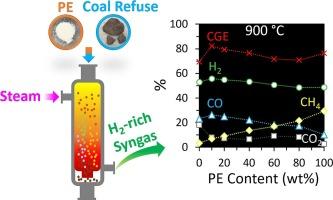低密度聚乙烯与煤矸石蒸汽共气化生产富氢合成气
IF 7.5
1区 工程技术
Q2 ENERGY & FUELS
引用次数: 0
摘要
气化为将废料转化为有价值的产品(如燃料和化学品)提供了一条前景广阔的途径。本研究调查了低密度聚乙烯(LDPE)和压缩浓缩池下流(代表煤垃圾(CR))在滴管反应器中的蒸汽共气化。研究了进料混合比(0-100 wt% LDPE)和温度(800-1000 °C)对合成气成分、焦油形成和工艺效率的影响。低密度聚乙烯的高挥发性使其比 CR 更具活性,但同时也促进了 2-7 环芳烃焦油的形成。温度升高可提高碳转化效率 (CCE)、冷气化效率 (CGE) 和合成气产量,但合成气的低热值 (LHV) 会降低。氢气是最主要的气体产物,达到 59 Vol%,H2/CO 摩尔比在 2.27 至 4.74 之间。通过催化炭气化和焦油裂解,CR 灰中的碱金属和碱土金属(AAEMs)(尤其是 K 和 Ca)可产生协同效应,提高合成气产量。赤铁矿(Fe2O3)和亚烟煤/烟煤灰渣被探索用作焦油转化催化剂。Fe2O3 的焦油重整效率达到 100%,而 Fe2O3 含量较低(15 wt%)的煤灰在裂解多环芳烃,尤其是萘方面的效率较低。这些发现证明了共气化技术的灵活性,可以针对特定的下游应用精确调整合成气的特性。进一步优化废物衍生催化剂可提高废物变能源工艺中气化的经济可行性。本文章由计算机程序翻译,如有差异,请以英文原文为准。

Hydrogen-rich syngas production from the steam co-gasification of low-density polyethylene and coal refuse
Gasification provides a promising pathway for transforming waste materials into valuable products, such as fuels and chemicals. This study investigates the steam co-gasification of low-density polyethylene (LDPE) and compressed thickener underflow, representative of coal refuse (CR), in a drop tube reactor. The effects of feed blend ratio (0–100 wt% LDPE) and temperature (800–1000 °C) on syngas composition, tar formation, and process efficiency are examined. The high volatility of LDPE makes it more reactive than CR but also promotes the formation of 2–7 ring aromatic tars. Increasing temperature improves carbon conversion efficiency (CCE), cold gas efficiency (CGE), and syngas yield, although the lower heating value (LHV) of syngas decreases. Hydrogen is the dominant gas product, reaching 59 vol% with the H2/CO molar ratio ranging from 2.27 to 4.74. Synergistic effects from alkali and alkali earth metals (AAEMs), particularly K and Ca, in CR ash enhance syngas yield by catalyzing char gasification and tar cracking. Hematite (Fe2O3) and ash from sub-bituminous/bituminous coals are explored as tar reforming catalysts. Fe2O3 achieves 100 % tar reforming efficiency, while coal ash, with a lower Fe2O3 content (15 wt%), is less effective at cracking polycyclic aromatic hydrocarbons, particularly naphthalene. These findings demonstrate the flexibility of co-gasification, allowing precise tuning of syngas characteristics for specific downstream applications. Further optimization of waste-derived catalysts could enhance the economic viability of gasification in waste-to-energy processes.
求助全文
通过发布文献求助,成功后即可免费获取论文全文。
去求助
来源期刊

Fuel
工程技术-工程:化工
CiteScore
12.80
自引率
20.30%
发文量
3506
审稿时长
64 days
期刊介绍:
The exploration of energy sources remains a critical matter of study. For the past nine decades, fuel has consistently held the forefront in primary research efforts within the field of energy science. This area of investigation encompasses a wide range of subjects, with a particular emphasis on emerging concerns like environmental factors and pollution.
 求助内容:
求助内容: 应助结果提醒方式:
应助结果提醒方式:


